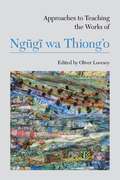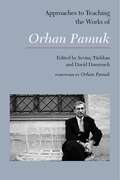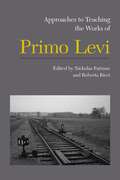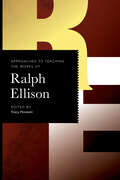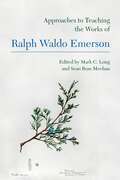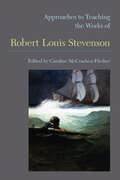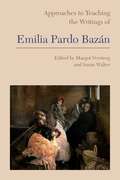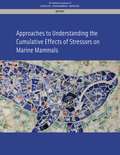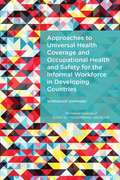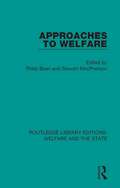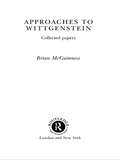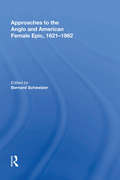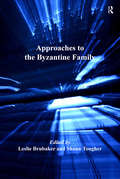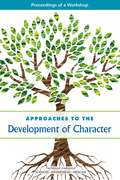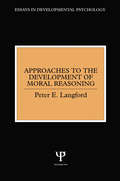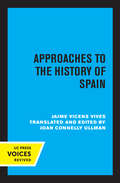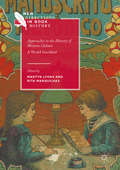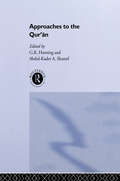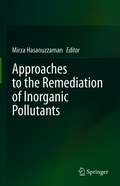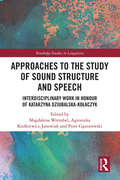- Table View
- List View
Approaches to Teaching the Works of Ngũgĩ wa Thiong'o (Approaches to Teaching World Literature #121)
by Oliver LoveseyNgũgĩ wa Thiong'o is one of the most important and celebrated authors of postindependence Africa as well as a groundbreaking postcolonial theorist. His work, written first in English, then in Gikuyu, engages with the transformations of his native Kenya after what is often termed the Mau Mau rebellion. It also gives voice to the struggles of all Africans against economic injustice and political oppression. His writing and activism have continued despite imprisonment, the threat of assassination, and exile.Part 1 of this volume, "Materials," provides resources and background for the teaching of Ngũgĩ's novels, plays, memoirs, and criticism. The essays of part 2, "Approaches," consider the influence of Frantz Fanon, Karl Marx, and Joseph Conrad on Ngũgĩ; how the role of women in his fiction is inflected by feminism; his interpretation and political use of African history; his experimentation with orality and allegory in narrative; and the different challenges of teaching Ngũgĩ in classrooms in the United States, Europe, and Africa.
Approaches to Teaching the Works of Octavia E. Butler (Approaches To Teaching World Literature Ser. #160)
by Tarshia L. StanleyOctavia E. Butler's works of science fiction invite readers to consider the structures of power in society and to ask what it means to be human. Butler addresses social justice issues such as poverty, racism, and violence against women and connects the history of slavery in the United States with speculation on a biologically altered future world.The first section of this volume, "Materials," lists secondary sources and interviews with Butler and suggests texts that instructors might pair with her works. Essays in the second section, "Approaches," situate Butler in science fiction, modernism, and Afrofuturism and provide interdisciplinary approaches from political science, philosophy, art, and digital humanities. The contributors present strategies for teaching Butler in literature courses as well as courses designed for adult learners, preservice teachers, and students at historically black colleges and universities.
Approaches to Teaching the Works of Orhan Pamuk (Approaches to Teaching World Literature #146)
by Sevinç Türkkan and David DamroschWinner of the Nobel Prize in Literature in 2006, Orhan Pamuk is Turkey's preeminent novelist and an internationally recognized figure of letters. Influenced by both Turkish and European literature, his works interrogate problems of modernity and of East and West in the Turkish context and incorporate the Ottoman legacy linguistically and thematically. The stylistic and thematic aspects of his novels, his intriguing use of intertextual elements, and his characters' metatextual commentaries make his work rewarding in courses on world literature and on the postmodern novel. Pamuk's nonfiction writings extend his themes of memory, loss, personal and political histories, and the craft of the novel.Part 1, "Materials," provides biographical background and introduces instructors to translations and critical scholarship that will elucidate Pamuk's works. In part 2, "Approaches," essays cover topics that support teachers in a range of classrooms, including Pamuk's use of the Turkish language, the political background to Pamuk's novels, the politics of translation and aesthetics, and Pamuk's works as world literature.
Approaches to Teaching the Works of Primo Levi (Approaches to Teaching World Literature #133)
by Nicholas Patruno Roberta RicciPrimo Levi, Holocaust survivor and renowned memoirist, is one of the most widely read writers of post-World War II Italy. His works are characterized by the lean, dispassionate eloquence with which he approaches his experience of incarceration in Auschwitz. His memoirs--as well as his poetry and fiction and his many interviews--are often taught in several fields, including Jewish studies and Holocaust studies, comparative literature, and Italian language and literature, and can enrich the study of history, psychology, and philosophy.The first part of this volume provides instructors with an overview of the available editions, anthologies, and translations of Levi's work and identifies other useful classroom aids, such as films, music, and online resources. In the second part, contributors describe different approaches to teaching Levi's work. Some, in presenting Survival in Auschwitz, The Reawakening, and The Drowned and the Saved, look at the place of style in Holocaust testimony and the reliability of memory in autobiography. Others focus on questions of translation, complicated by the untranslatable in the language and experiences of the concentration camps, or on how Levi incorporates his background as a chemist into his writing, most clearly in The Periodic Table.
Approaches to Teaching the Works of Ralph Ellison (Approaches to Teaching World Literature #177)
by Tracy FloreaniOne of the most important American authors and public intellectuals of the twentieth century, Ralph Ellison had a keen and unsentimental understanding of the relationship between race, art, and activism in American life. He contended with other writers of his day in his examination of the entrenched racism in society, and his writing continues to inform national conversations in letters and culture.The essays in Approaches to Teaching the Works of Ralph Ellison will help instructors in colleges, high schools, and prisons teach not only the indispensable Invisible Man but also Ellison's short stories, his essays, and the two editions of his second, unfinished novel, Juneteenth and Three Days before the Shooting . . . . In considering Ellison's works in relation to jazz, technology, humor, politics, queerness, and disability, this volume mirrors the breadth of Ellison's own life, which extended from the Jim Crow era through the Black Power movement.
Approaches to Teaching the Works of Ralph Waldo Emerson (Approaches to Teaching World Literature #155)
by Mark C. Long and Sean Ross MeehanA leader of the transcendentalist movement and one of the country's first public intellectuals, Ralph Waldo Emerson has been a long-standing presence in American literature courses. Today he is remembered for his essays, but in the nineteenth century he was also known as a poet and orator who engaged with issues such as religion, nature, education, and abolition.This volume presents strategies for placing Emerson in the context of his time, for illuminating his rhetorical techniques, and for tracing his influence into the present day and around the world. Part 1, "Materials," offers guidance for selecting classroom editions and information on Emerson's life, contexts, and reception. Part 2, "Approaches," provides suggestions for teaching Emerson's works in a variety of courses, not only literature but also creative writing, religion, digital humanities, media studies, and environmental studies. The essays in this section address Emerson's most frequently anthologized works, such as Nature and "Self-Reliance," along with other texts including sermons, lectures, journals, and poems.
Approaches to Teaching the Works of Robert Louis Stevenson (Approaches to Teaching World Literature #124)
by Caroline McCracken-FlesherAlthough Robert Louis Stevenson was a late Victorian, his work--especially Treasure Island and The Strange Case of Dr. Jekyll and Mr. Hyde--still circulates energetically and internationally among popular and academic audiences and among young and old. Admired by Henry James, Vladimir Nabokov, and Jorge Luis Borges, Stevenson's fiction crosses the boundaries of genre and challenges narrow definitions of the modern and the postmodern.Part 1 of this volume, "Materials," provides an introduction to the writer's life, a survey of the criticism of his work, and a variety of resources for the instructor. In part 2, "Approaches," thirty essays address such topics as Stevenson's dialogue with James about literature; his verse for children; his Scottish heritage; his wanderlust; his work as gothic fiction, as science fiction, as detective fiction; his critique of imperialism in the South Seas; his usefulness in the creative writing classroom; and how Stevenson encourages expansive thinking across texts, times, places, and lives.
Approaches to Teaching the Writings of Emilia Pardo Bazán (Approaches to Teaching World Literature #147)
by Margot Versteeg Susan Walter"Emilia Pardo Bazán (1851-1921) was the most prolific and influential woman writer of late nineteenth-century Spain," write the editors of this volume in the MLA's Approaches to Teaching World Literature series. Contending with the critical literary, cultural, and social issues of the period, Pardo Bazán's novels, novellas, short stories, essays, plays, travel writing, and cookbooks offer instructors countless opportunities to engage with a variety of critical frameworks. The wide range of topics in the author's works, from fashion to science and technology to gender equality, and the brilliance of her literary style make Pardo Bazán a compelling figure in the classroom.Part 1, "Materials," provides biographical and critical resources, an overview of Pardo Bazán's vast and diverse oeuvre, and a literary-historical time line. It also reviews secondary sources, editions and translations, and digital resources. The twenty-three essays in part 2, "Approaches," explore various issues that are central to teaching Pardo Bazán's works, including the author's engagement with contemporary literary movements, feminism and gender, nation and the late Spanish empire, Spanish and Galician identities, and nineteenth-century scientific and medical discourses. Film adaptations and translations of Pardo Bazán's works are also addressed. Highlighting the artistic, social, and intellectual currents of Pardo Bazán's writings, this volume will assist instructors who wish to teach the author's works in courses on world literature, nineteenth-century literature, and gender studies as well as in Spanish-language courses.
Approaches to Understanding the Cumulative Effects of Stressors on Marine Mammals
by Engineering Medicine National Academies of SciencesMarine mammals face a large array of stressors, including loss of habitat, chemical and noise pollution, and bycatch in fishing, which alone kills hundreds of thousands of marine mammals per year globally. To discern the factors contributing to population trends, scientists must consider the full complement of threats faced by marine mammals. Once populations or ecosystems are found to be at risk of adverse impacts, it is critical to decide which combination of stressors to reduce to bring the population or ecosystem into a more favorable state. Assessing all stressors facing a marine mammal population also provides the environmental context for evaluating whether an additional activity could threaten it. Approaches to Understanding the Cumulative Effects of Stressors on Marine Mammals builds upon previous reports to assess current methodologies used for evaluating cumulative effects and identify new approaches that could improve these assessments. This review focuses on ways to quantify exposure-related changes in the behavior, health, or body condition of individual marine mammals and makes recommendations for future research initiatives.
Approaches to Universal Health Coverage and Occupational Health and Safety for the Informal Workforce in Developing Countries: Workshop Summary
by Engineering Medicine National Academies of SciencesUniversal health coverage (UHC) has been recognized by the World Health Organization as a key element in reducing social inequality and a critical component of sustainable development and poverty reduction. In most of the world UHC is sought through a combination of public and private-sector health care systems. In most low- and middle-income countries health systems are evolving to increasingly rely on the private sector because the public sector lacks the infrastructure and staff to meet all health care needs. With growing individual assets available for private-sector expenditure, patients often seek better access to technology, staff, and medicines. However, in low-income countries nearly 50 percent of health care financing is out-of-pocket. With the expected increase in the overall fraction of care provided through the private sector, these expenditures can be financially catastrophic for individuals in the informal workforce. In the global workforce of approximately 3 billion people, only 10 to 15 percent are estimated to have some type of access to occupational health services. The informal workforce is growing worldwide, and the degree to which its occupational health needs are satisfied depends on the capabilities of the general health care system. In July 2014, the Institute of Medicine held a workshop on approaches to universal health coverage and occupational health and safety for informal sector workers in developing countries. This report summarizes the presentations and discussions from this workshop. Approaches to Universal Health Coverage and Occupational Health and Safety for the Informal Workforce in Developing Countries identifies best practices and lessons learned for the informal workforce in developing countries in the financing of health care with respect to health care delivery models that are especially suitable to meeting a population's needs for a variety of occupational health issues, including the prevention of or mitigation of hazardous risks and the costs of providing medical and rehabilitation services and other benefits to various types of workers within this population. These experiences and lessons learned may be useful for stakeholders in moving the discussions, policies, and mechanisms forward to increase equitable access to quality health services without financial hardship for the informal workforce.
Approaches to Welfare (Routledge Library Editions: Welfare and the State #1)
by Philip Bean Stewart MacphersonOriginally published in 1983 Approaches to Welfare provides a unique introduction to the study of social welfare in Britain. The contributions, by distinguished figures in the field of social welfare and social policy, explore all the dimensions of the study of social welfare demonstrating that not only have social policies changed in the forty years since the establishment of the welfare state, but so too have approaches to their analysis. The contributors consider these changes in relation to a wide range of social welfare issues, illuminating the diversity and variety within the contemporary study of social policy.
Approaches to Wittgenstein: Collected Papers
by Brian McGuinnessApproaches to Wittgenstein brings together for the first time the many varied aspects of Wittgenstein's life, philosophy, and aesthetic attitudes.
Approaches to Work-Based Learning in Higher Education: Improving Graduate Employability
by Matthew BarrApproaches to Work-Based Learning in Higher Education provides a comprehensive introduction to the delivery of university-level work-based learning (WBL) for educators and policymakers. The contributing authors draw from their wealth of experience of developing apprenticeships, placement programmes and other work-based learning opportunities, advising on best practice when delivering learning in partnership with industry.Supported by a unique balance of practical and theoretical insight, including international perspectives on how common challenges may be addressed, this essential volume explores the following key themes: Pedagogies – this section outlines established best practice in delivery of WBL for higher education and offers suggestions for how readers may continue to develop and improve their provision. Projects – this section covers a range of approaches to work-based learning within higher education and explores examples of this in practice, including live briefs, work placements and industrial project-based learning. Apprenticeships – this section focuses specifically on work-based degree programmes, covering their design, delivery, implementation and assessment. A must-read for anyone working within higher education policy or practice, this book provides readers with the tools to successfully navigate work-based learning, as well as strategies for ensuring and enhancing the quality of the learning experience.
Approaches to the Anglo and American Female Epic, 1621-1982
by Bernard SchweizerEpic has long been regarded as the exclusive domain of the male literary genius and as an incarnation of patriarchal values. This provocative collection of essays challenges such a hegemonic stereotype by demonstrating the ways in which women writers have successfully adapted the masculine epic tradition to suit their own aesthetic needs and to express their own heroic literary, social, and historical visions. Bringing the female epic out of the shadows, the contributors rethink generic boundaries to illuminate this heretofore hidden literary practice. The essays range from Mary Tighe to Rebecca West from Elizabeth Barrett Browning to Gwendolyn Brooks, and from Frances Burney to Virginia Woolf. Bernard Schweizer's introduction, titled 'Muses with Pens,' connects the trajectory of ideas and influences in the individual essays to demonstrate how each participates in reclaiming for women writers a place in the development of a female epic tradition. The volume will be an invaluable resource for scholars working on issues related to genre, canon formation, and the evolution of female literary authority.
Approaches to the Byzantine Family (Birmingham Byzantine and Ottoman Studies #14)
by Shaun Tougher Leslie BrubakerThe study of the family is one of the major lacunas in Byzantine Studies. Angeliki Laiou remarked in 1989 that ’the study of the Byzantine family is still in its infancy’, and this assertion remains true today. The present volume addresses this lacuna. It comprises 19 chapters written by international experts in the field which take a variety of approaches to the study of the Byzantine family, and embrace a chronological span from the later Roman to the late Byzantine empire. The context is established by chapters focusing on the Roman roots of the Byzantine family, the Christianisation of the family, and the nature of the family in contemporaneous cultures (the late antique west and the Islamic east). Key methodological approaches to the Byzantine family are highlighted and discussed, in particular prosopographical and life course approaches. The contribution of hagiography to the understanding of the Byzantine family is analysed by several authors; other chapters on the family and children in art and on the archaeology of the Middle Byzantine house explore the material evidence that can shed light on the Byzantine family. Overall, the diversity of families that existed in Byzantium (blood, fictive, metaphorical) is emphasised, and chapters consider the specific cases of ascetic, monastic, aristocratic and peasant families, as well as the imperial family, which is illuminated by the comparative case of a Caliphal family. The volume is topped and tailed by a Preface and an Afterword by the editors, which address the state of the field and consider the way ahead. Thus the volume is vital in putting the subject of the Byzantine Family in sharp focus and setting the research agenda for the future.
Approaches to the Conformational Analysis of Biopharmaceuticals (Protein Science)
by Roger L. LundbladThe activity of many biopharmaceutical polymers is dependent on conformation, and the next several years will see increased interest in the conformational analysis of these polymers resulting from the development of biosimilar or "follow-on" biological products. While a wide variety of approaches to analysis exists, finding the most viable ones wou
Approaches to the Development of Character: Proceedings of a Workshop
by Engineering Medicine National Academies of SciencesThe development of character is a valued objective for many kinds of educational programs that take place both in and outside of school. Educators and administrators who develop and run programs that seek to develop character recognize that the established approaches for doing so have much in common, and they are eager to learn about promising practices used in other settings, evidence of effectiveness, and ways to measure the effectiveness of their own approaches. In July 2016, the National Academies of Sciences, Engineering, and Medicine held a workshop to review research and practice relevant to the development of character, with a particular focus on ideas that can support the adults who develop and run out-of-school programs. This publication summarizes the presentations and discussions from the workshop.
Approaches to the Development of Moral Reasoning (Essays in Developmental Psychology)
by Peter E. LangfordThe first part of the book offers a survey of current approaches to the development of moral reasoning: those of Freud, ego psychology, Piaget and Kohlberg. The approach of Kohlberg has been popular because he was able to give an impressive account of findings from the key method of interviews, the other crucial method being naturalistic observation of moral discourse. The accounts of interview evidence given by ego psychology and Piaget were less comprehensive and less impressive. Naturalistic studies have either been impressionistic or less detailed in their methods of analysis.The second part of the book argues that the impressive nature of Kohlberg's later evidence for his view that moral reasoning passes through a sequence of stages is in part illusory, because his theory predicts that specific types of reply will show specific developmental patterns. However, as data are always reported in terms of stages, which amalgamate very disparate types of reply, it is impossible to know whether the specific types of reply follow their predicted developmental courses or not. Reasons given for assigning given types of reply to a stage are also often doubtful. This leads to discussion of studies that have reported findings in terms of specific types of reply (weakly interpretive methods), as opposed to Kohlberg's stage-based and strongly interpretive methods. Findings from these disconfirm Kohlberg's theory at several crucial points.The second and third parts of the book also examine findings from non-Kohlbergian interviews and other methods, again advocating that weakly interpretive and largely descriptive presentation of findings is preferable to strongly interpretive techniques. It is argued that a wide variety of mechanisms suggested by the theories outlined in the first part of the book, as well as others drawn from general theories of personality development, are able to explain existing descriptive developmental findings. The task for the future is to assess the relative importance of these mechanisms.
Approaches to the Evolution of Language: Language Evolution
by Rudolf BothaHow can we unravel the evolution of language, given that there is no direct evidence about it? Rudolf Botha addresses this intriguing question in his fascinating new book. Inferences can be drawn about language evolution from a range of other phenomena, serving as windows into this prehistoric process. These include shell-beads, fossil skulls and ancestral brains, modern pidgin and creole languages, homesign systems and emergent sign languages, modern motherese, language use of modern hunter-gatherers, first language acquisition, similarities between language and music, and comparative animal behaviour. The first systematic analysis of the Windows Approach, it will be of interest to students and researchers in many disciplines, including anthropology, archaeology, linguistics, palaeontology and primatology, as well as anyone interested in how language evolved.
Approaches to the Evolution of Language: Language in Prehistory
by Alan BarnardFor ninety per cent of our history, humans have lived as 'hunters and gatherers', and for most of this time, as talking individuals. No direct evidence for the origin and evolution of language exists; we do not even know if early humans had language, either spoken or signed. Taking an anthropological perspective, Alan Barnard acknowledges this difficulty and argues that we can nevertheless infer a great deal about our linguistic past from what is around us in the present. Hunter-gatherers still inhabit much of the world, and in sufficient number to enable us to study the ways in which they speak, the many languages they use, and what they use them for. Barnard investigates the lives of hunter-gatherers by understanding them in their own terms, to create a book which will be welcomed by all those interested in the evolution of language.
Approaches to the History of Spain
by Jaime Vicens VivesThis title is part of UC Press's Voices Revived program, which commemorates University of California Press’s mission to seek out and cultivate the brightest minds and give them voice, reach, and impact. Drawing on a backlist dating to 1893, Voices Revived makes high-quality, peer-reviewed scholarship accessible once again using print-on-demand technology. This title was originally published in 1970.
Approaches to the History of Written Culture: A World Inscribed (New Directions in Book History)
by Martyn Lyons Rita MarquilhasThis book investigates the history of writing as a cultural practice in a variety of contexts and periods. It analyses the rituals and practices determining intimate or 'ordinary' writing as well as bureaucratic and religious writing. From the inscribed images of 'pre-literate' societies, to the democratization of writing in the modern era, access to writing technology and its public and private uses are examined. In ten studies, presented by leading historians of scribal culture from seven countries, the book investigates the uses of writing in non-alphabetical as well as alphabetical script, in societies ranging from Native America and ancient Korea to modern Europe. The authors emphasise the material characteristics of writing, and in so doing they pose questions about the definition of writing itself. Drawing on expertise in various disciplines, they give an up-to-date account of the current state of knowledge in a field at the forefront of 'Book History'.
Approaches to the Qur'an (SOAS/Routledge Studies on the Middle East)
by G. R. Hawting Abdul-Kader A. ShareefIn recent years, the study of the Qur'an and its interpretation has expanded to incorporate insights gained from historical, biblical, literary and critical studies. A variety of approaches to the Qur'an and the Muslim exegetical tradition are currently available. Approaches to the Qur'an consists of thirteen essays by leading scholars, both Muslim and non-Muslim, in the fields of qur'anic studies and Islamic studies. Taken together, they offer a sample of the aims, methods and topics of enquiry now being pursued. Each study has a full critical apparatus, and the book includes a consolidated bibliography which will be of great value to students and specialists.
Approaches to the Remediation of Inorganic Pollutants
by Mirza HasanuzzamanIn this comprehensive book, plant biologists and environmental scientists present the latest information on different approaches to the remediation of inorganic pollutants. Highlighting remediation techniques for a broad range of pollutants, the book offers a timely compilation to help readers understand injury and tolerance mechanisms, and the subsequent improvements that can be achieved by plant-based remediation. Gathering contributions by respected experts in the field, the book represents a valuable asset for students and researchers, particularly plant physiologists, environmental scientists, biotechnologists, botanists, soil chemists and agronomists.
Approaches to the Study of Sound Structure and Speech: Interdisciplinary Work in Honour of Katarzyna Dziubalska-Kołaczyk (Routledge Studies in Linguistics)
by Magdalena Wrembel Agnieszka Kiełkiewicz-Janowiak Piotr GąsiorowskiThis innovative work highlights interdisciplinary research on phonetics and phonology across multiple languages, building on the extensive body of work of Katarzyna Dziubalska-Kołaczyk on the study of sound structure and speech. // The book features concise contributions from both established and up-and-coming scholars who have worked with Katarzyna Dziubalska-Kołaczyk across a range of disciplinary fields toward broadening the scope of how sound structure and speech are studied and how phonological and phonetic research is conducted. Contributions bridge the gap between such fields as phonological theory, acoustic and articulatory phonetics, and morphology, but also includes perspectives from such areas as historical linguistics, which demonstrate the relevance of other linguistic areas of inquiry to empirical investigations in sound structure and speech. The volume also showcases the rich variety of methodologies employed in existing research, including corpus-based, diachronic, experimental, acoustic and online approaches and showcases them at work, drawing from data from languages beyond the Anglocentric focus in existing research. // The collection reflects on Katarzyna Dziubalska-Kołaczyk’s pioneering contributions to widening the study of sound structure and speech and reinforces the value of interdisciplinary perspectives in taking the field further, making this key reading for students and scholars in phonetics, phonology, sociolinguistics, psycholinguistics, and speech and language processing.
